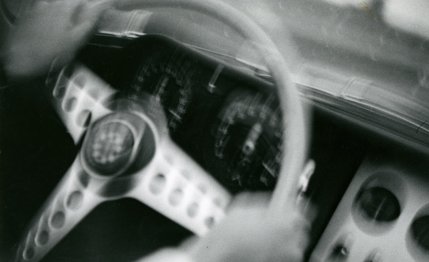Deceleration Unlimited
The demand for stopping power with 265 bhp under the hood and a top speed of a century and a half assumes proportions not generally realized. Jaguar has solved the problem by using 11-inch discs at the front (mounted in the wheels) and 10-inch inboard discs at the rear, servo-assisted by a large capacity Dunlop booster (made under license from Kelsey-Hayes of the United States) activating two master cylinders. This works so well that retardation is limited only by the coefficient of friction between the tires and the road surface.
Staff testers agreed unanimously that the brakes are exceptional in capacity and fade resistance. They showed no signs of pulling the car after a series of crash stops from high speeds following acceleration runs with a purposely-set below-minimum pull-up distance. The fact that this maneuver could be carried out repeatedly in complete safety indicates the value of race-tested brakes. The D-Type in original Le Mans form, of course, had 12¾ -inch discs with three brake pads in front and two at the rear while the E-Type has two pads per disc. The only uncomfortable moment encountered with the E-Type’s brakes was during the first application after they had become wet. They could pull the car left or right or apparently not work at all, but the second jab at the pedal brought the car to a swift, sure stop since the discs dry out faster than drum units. Added benefits of the disc system are well-known: the pads can be replaced quickly and they are self-adjusting.
|
|
The Kelsey-Hayes power assist unit has an air reservoir which permits about 15 operations of the pedal after the power is turned off, certainly enough to provide a safety margin for stopping in the event of its failure. It operates directly on the brake pedal and is familiar to drivers of many American cars. The use of two master cylinders means that even if brakes on one set of wheels (front or back) should fail, there would still be a system that works. Both have electrical switches in their reservoir caps so that if the fluid drops below a safe level, a red light comes on on the dashboard. This light also signals that the handbrake is not fully released. On the E-Type we tested, the handbrake was adequate for holding the car on steep hills, but if it’s anything like the handbrake on other disc-braked Jags we’ve driven, it will get out of adjustment soon. With all the other innovations on the car, it seems too bad Jaguar did not install Dunlop’s latest self-adjusting handbrake mechanism. Perhaps they will on later cars; we understand this has already been incorporated on late 3.8’s.
If we can agree that pedal pressures are “moderate” we would also state they are not vague. The action of the power assist is just that, not a case of “power control” being actuated with the brake pedal serving as a switch. The driver always has a definite control over how fast the car stops. Braking is even with a small amount of nose-bobbing and the shape of the seats helps keep the passenger from sprawling over the hood.
Gentle Guidance
A small-diameter, spring-spoked, wood-rimmed steering wheel works through rack and pinion steering to give the E-Type almost MGA-like handiness. There is quite a heavy return action, but it gives the car great directional stability. Taking your hands off the wheel at 110 or more can be done with impunity. At low speeds, the force needed to turn the wheels is quite high, but the E-Type is a man’s car and most won’t complain about this. It’s also a car not intended for puttering around, so at turnpike speeds it’s light and direct yet retains excellent feel.
|
|
Most of our driving was done with the wheel all the way forward and the column in the top position. Steering precision was excellent and with 2¾ turns lock to lock, play was virtually nonexistent. Road reactions would be transmitted to the wheel, however, which needed a firm hand when cornering.
The car is well balanced for high-speed handling. There’s some amount of initial understeer yet with plenty of power on tap, the rear end will hang out in an impressive but very controllable attitude. The progression of the rear end toward the outside of a curve is a usable, not unpleasant phenomenon and the steering becomes very nearly neutral in behavior. Steering response when going into a corner, coming out of one or correcting a rear-end slide was instant, again a remarkable achievement in view of the basic stability of the car. With anti-roll bars fitted both front and rear, and a very low center of gravity, body lean was negligible right up to the maximum speed at which any given corner could be taken. When at the wheel, body lean was felt even less than photographs later showed it to be.
Most drivers will be impressed at the way the E-Type enhances their driving. This is not to say that any clod can slip behind the wheel and immediately break lap records, but an enthusiastic, non-racing amateur will find the car greatly extends his capabilities, while those with a definite competition bent will find it a useful, potent road tool. It will be interesting to watch the E-Type in American competition during 1962.
View Photos
View Photos


Leave a Reply